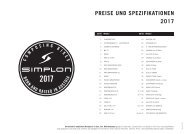201506_0276001SPI_System_Manual_25_45kmh_PerfLine_Intuvia_WEU_oReg
You also want an ePaper? Increase the reach of your titles
YUMPU automatically turns print PDFs into web optimized ePapers that Google loves.
English–9<br />
Code Cause Corrective Measure<br />
610 Battery pack voltage error Restart the system. If the problem persists, contact your Bosch eBike<br />
dealer.<br />
620 Charging error Replace the charger. Contact your Bosch eBike dealer.<br />
640 Internal battery pack error Restart the system. If the problem persists, contact your Bosch eBike<br />
dealer.<br />
655 Multiple battery pack errors Switch off the eBike system. Remove the battery pack and reinsert it. Restart<br />
the system. If the problem persists, contact your Bosch eBike dealer.<br />
656 Software version error Contact your Bosch eBike dealer so that he can perform a software<br />
update.<br />
7xx Transmission error Please observe the operating instructions provided by the transmission<br />
manufacturer.<br />
No display Internal error of the on-board computer Restart your eBike system by switching it off and back on.<br />
Power Supply of External Devices<br />
via USB Connection<br />
With the USB connection, it is possible to operate and charge<br />
most devices whose power supply is possible via USB (e.g.,<br />
various mobile phones).<br />
Prerequisite for charging is that the on-board computer and a<br />
sufficiently charged battery pack are inserted in the eBike.<br />
Open the protective cap 8 of the USB port on the on-board<br />
computer. Connect the USB connection of the external device<br />
to the USB port 7 on the on-board computer using the USB<br />
charging cable Micro A – Micro B (available from your Bosch<br />
eBike dealer).<br />
Once the consumer has been disconnected, the USB connection<br />
must be sealed again carefully with the protective cap 8.<br />
A USB connection is not a waterproof plug-in connection.<br />
When riding in the rain, an external device must<br />
not be connected and the USB connection must be completely<br />
sealed with the protective cap 8.<br />
Notes on Riding with the eBike <strong>System</strong><br />
When does the eBike Drive Unit Operate?<br />
The eBike drive unit assists you when riding, as long as you<br />
step into the pedals. Without pedaling, there is no assistance.<br />
The motor output always depends on the amount of your pedaling<br />
power.<br />
When applying less pedaling power, the assistance or support<br />
will be lower than when applying a lot of pedaling power. This<br />
applies independent of the assistance Level.<br />
The eBike drive automatically switches off at speeds in excess<br />
of <strong>25</strong>/45 km/h. When the speed falls below <strong>25</strong>/45 km/h, the<br />
drive is automatically available again.<br />
An exception applies to the push-assistance function, in which<br />
the eBike can be pushed at low speed without pedalling. The<br />
pedals may also rotate when the push assistance is used.<br />
The eBike can also be ridden as a normal bicycle without assistance<br />
at any time, by either switching off the eBike system<br />
or setting the assistance level to “OFF”. The same applies<br />
when the battery pack is empty.<br />
Interaction of the eBike <strong>System</strong> with the Bicycle Gears<br />
The bicycle gears should be used as with a normal bicycle,<br />
even with eBike motor assistance (please observe the operating<br />
instructions of your eBike).<br />
Independent of the type of gearing, it is recommended to<br />
briefly interrupt the pedaling while changing gears. This<br />
makes changing gears easier and reduces the wear of the<br />
drive train.<br />
By selecting the right gear, you can increase the speed and<br />
range with the same pedaling effort.<br />
For this reason, follow the shift recommendations provided<br />
by indications g and h on your display. If indication g is displayed,<br />
you should shift to a higher gear with lower cadence.<br />
If indication h is displayed, you should select a lower gear with<br />
higher cadence.<br />
Gathering First Experience<br />
It is recommended to gather first experience with the eBike<br />
away from roads with heavy traffic.<br />
Try out the different assistance levels. As soon as you feel<br />
safe, you can participate in traffic with the eBike as with any<br />
other bicycle.<br />
Test the operating range of your eBike under different conditions<br />
before planning longer and more challenging rides.<br />
Influences on the Operating Range<br />
The operating range depends on many factors, such as:<br />
– Assistance level,<br />
– Gear-switching behaviour,<br />
– Bicycle tyres and tyre pressure,<br />
– Age and condition of the battery pack,<br />
– Route profile (inclines) and road or path conditions (road<br />
or path surface),<br />
– Head wind and ambient temperature,<br />
– Weight of the eBike, rider and equipment/luggage.<br />
Bosch eBike <strong>System</strong>s 0 276 001 SPI | (3.6.15)








